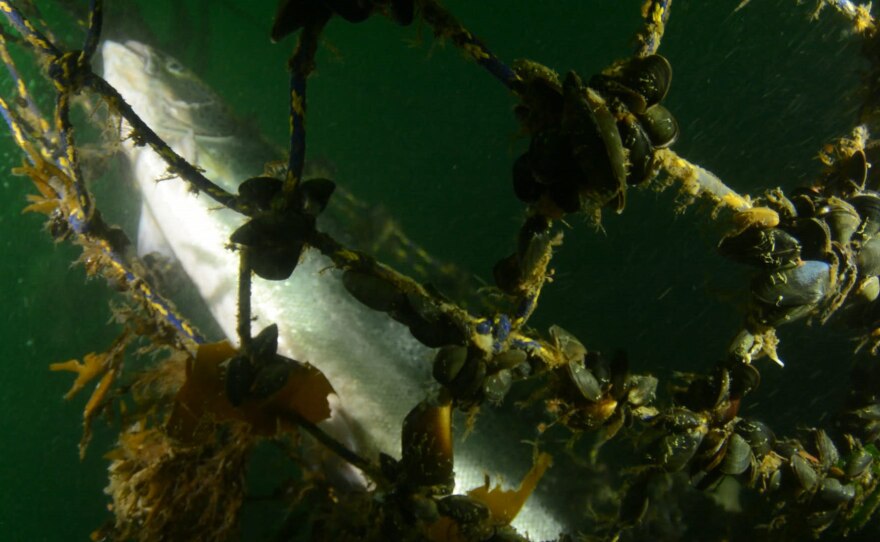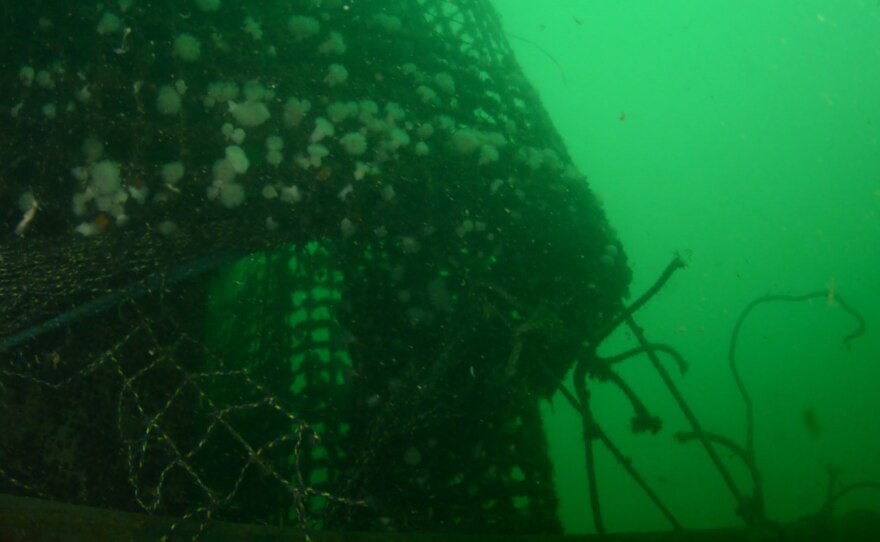Washington state officials are looking at some new suspects in the collapse of an Atlantic salmon farm: sea creatures clogging the floating structure’s nets.
Nets from the fish farm off Cypress Island were heavy with marine life like mussels, sea anemones and algae, according to eyewitness accounts and underwater videos obtained by KUOW. Such “biofouling” can amplify the force of tidal currents as they push through the mesh of underwater net-pens.
The salmon farm broke away from its moorings on two occasions in July after strong tidal currents swept past Cypress Island. It collapsed altogether in August, letting 160,000 Atlantic salmon escape into Puget Sound.
Net growth, net loss
On the sunny Saturday when the salmon farm started to collapse, Jill Davenport was out boating with her family.
“This summer, we did a lot of crabbing,” she said.
While the family was setting out pots for Dungeness crab, they motored past the trio of salmon farms floating in Cypress Island’s Deepwater Bay.
“I remember when they were put in in the 80s,” said Davenport, who grew up in Anacortes. “We’ve bought a lot of that farm-raised Atlantic salmon from Costco and we love it.”
Each fish farm was a floating grid of pontoons and nets, altogether bigger than a football field. Davenport saw the middle one start to tear apart. A heavy chain started dragging across the top of the net-pens, pulled by some invisible force. Walkways around the perimeter started to twist and buckle, at first subtly, then dramatically.
"It was probably a half hour after we got there when we could see the underside of the pens," she said. "It's like, okay, something is seriously wrong when you can see seaweed. So I called 911.”
Investigators have been asking whether the seaweed was a cause as well as a symptom of the disaster.
But not just seaweed: All sorts of sea life was clinging to the submerged portion of the farm.
A diver inspects growth on one of the surviving Cypress Island salmon farms in September. Washington Department of Natural Resources video via KUOW public records request.
Samish Nation tribal chair Tom Wooten witnessed its nets being loaded onto a dock in Anacortes during the removal of the ruined fish farm.
“There was a huge mussel growth on those predator nets, which keep the seals and sea lions from eating the Atlantic salmon,” Wooten said.
Wooten is no fan of Atlantic salmon in the Pacific Northwest.
“They belong in the Atlantic Ocean,” Wooten said. “That’s where they come from.”
He said the nets were clogged with thick clumps of blue mussels.
“I mean, you couldn’t see through the netting. It was that packed with mussels,” Wooten said. “It was a big year for mussels, I guess.”
Up close, down deep
Like all salmon farms in the United States, the three Cypress Island farms are owned by a Canadian company called Cooke Aquaculture. It’s also the leading producer of farmed salmon in Canada.
While Cooke was still trying to stabilize its damaged fish farm, a Canadian filmmaker and activist named April Bencze dove into Deepwater Bay with scuba gear and a video camera.
As she prepared to dive in, alone, Cooke employees radioed her support boat. They warned her not to dive near their emergency operation and said they were calling the county sheriff. Bencze dove in anyway.
“I’ve never been met at a fish farm without them freaking out,” said Bencze, who has filmed the depths of salmon farms near her Vancouver Island home. British Columbia has more than 100 salmon farms.
“Extremely dangerous. No back up diver, no communications. I called the sheriff and Coast Guard to try to intervene," Kevin Bright with Cooke Aquaculture emailed state officials the next day.
Visibility was poor, so Bencze couldn’t see much of the net through the murk. But as she drifted along its length, her video shows some areas of netting only lightly obscured by seaweed. Other areas are covered in bushy algae and cauliflower-like sea anemones in white and orange. Clusters of small blue mussels cling to the nylon netting in other places.
Bencze said the farm looked like a hurricane hit it underwater, with snapped cables and mangled metal. But she said the net didn’t have more creatures growing on it than she’s seen diving near salmon farms off Vancouver Island.
“There seemed to be the typical amount of growth,” she said.
At one point, fish farm workers at the surface signaled Bencze directly with a series of triple taps on a piece of metal. A distress signal designed to get her to come to the surface, which she did.
All eight, now seven, salmon farms in Washington state float in public waters. According to the Washington Department of Natural Resources, which leases the areas, the public can use those waters as long as they don’t interfere with fish farms’ operations.
[asset-images[{"caption": "Anemones, mussels and other sea life on the netting of a collapsed salmon farm off Cypress Island on Aug. 24, 2017.", "fid": "142047", "style": "placed_full", "uri": "public://201801/Underwater_00_09_22_14.png", "attribution": "Credit April Bencze"}]]In the long, sunlit days of a Northwest summer, algae grows quickly on almost anything underwater that doesn’t swim away. So do little animals like barnacles and mussels.
Together, they’re called fouling organisms because of how they can foul up underwater equipment.
They are a constant challenge for salmon farmers.
“If the nets are clean, the fish are happy, essentially, in layman's terms,” Kevin Onclin of Campbell River, British Columbia, said.
Onclin’s very specialized business, Badinotti Net Services Canada, cleans and repairs nets for salmon farms in British Columbia.
In the fast-growing summer months, many salmon farms in Canada clean their nets every two weeks; in Norway, the world’s leading producer of farmed salmon, nets are cleaned as often as every five days. Onclin said there are no standards or best practices for how often nets should be cleaned.
“All fish need a good water flow and especially salmon. They like well-oxygenated water, so it's not in any farmer's best interest to have dirty, really heavily fouled nets,” Onclin said.
Salmon farms generally aren’t mom-and-pop operations — they’re mostly run by multinational companies like Cooke or Marine Harvest of Norway. They use high-tech machinery including remote-controlled, underwater pressure washers sometimes called “net-cleaning robots.” The remotely operated vehicles blast high-pressure water to strip nets of their clingy stowaways.
“That would remind you of sitting in a gaming chair with an Xbox controller, driving these remote operated cleaners over the net,” Onclin said. “It's like playing a video game, to be honest.”
Fouling organisms can add several tons to the weight of a salmon farm. By blocking water that would otherwise flow through the nets, they can also make salmon farms bear the brunt of tidal currents.
“The difference can be exponential, it can be very dramatic,” marine engineer Matt Clarke with Poseidon Ocean Systems in Campbell River said. “It’s pretty simple physics.”
Engineering studies show heavy fouling can increase the sideways drag on a net more than twelvefold.
Fish farms are usually engineered to withstand such forces, with a wide safety margin added on top.
A properly designed fish farm should be able to withstand tidal currents, even if its nets are heavily fouled, according to Clarke.
“We see lots of farms that have more fouling than the engineers would like to see, and we’ve never seen a farm break up like you did down there,” he said.
But there was lots of evidence that the ill-fated Cypress Island farm wasn’t in proper condition last year.
Cooke and regulators knew as far back as February that the farm was suffering from corrosion and metal fatigue. Cooke was planning to replace it entirely in the fall, after one last harvest of 3 million pounds of fish.
A month before the collapse ruined that plan, the salmon farm got pushed around by currents and broke free of its moorings twice in July. The company told regulators it did “remedial” cleaning of its nets afterward.
I asked Cooke Aquaculture about the fouling and cleaning of its farms. Cooke vice president Joel Richardson said in an email that the company can’t comment on any matters that may be under investigation.
In September, the Department of Natural Resources recorded underwater videos of the two remaining salmon farms off Cypress Island. The agency said it wanted to compare the condition of the nets on the farms to help understand the causes of the August collapse.
The conditions shown in the videos vary. In places, the sea life is so thick, you can’t see the mesh of the nets until the diver brushes the growth out of the way with his neoprene glove.
State investigators have also requested detailed records of how and how often Cooke cleaned its nets.
Whether or not all the underwater hitchhikers played a role in the collapse, they could mean trouble for Cooke. The company’s lease with the Department of Natural Resources requires Cooke keep its farm in a clean and safe condition and states the company will remove "any marine growth before it accumulates." Heavy fouling could be seen as evidence that it has broken its lease.
[asset-images[{"caption": "", "fid": "142048", "style": "placed_wide", "uri": "public://201801/cooke_ags_leasetenantrepairs.jpg", "attribution": ""}]]
The state revoked Cooke’s lease for a salmon farm near Port Angeles in December after finding what it called “serious safety problems.”
Cooke sued the state in Clallam County Superior Court in January to keep that lease.
The Department of Natural Resources expects its investigation into the great Atlantic salmon escape of 2017 to wrap up by the end of January.
[asset-images[{"caption": "Plumose anemones and other sea life on the netting of a collapsed Atlantic salmon farm off Cypress Island on Aug. 24, 2017.", "fid": "141973", "style": "placed_wide", "uri": "public://201801/AnemoneNetGIF.gif", "attribution": "Credit April Bencze"}]]John Ryan loves getting tips and documents. He can be reached at jryan@kuow.org or on the encrypted Signal or WhatsApp apps at 1-401-405-1206 (whistleblowers, never do so from a work or government device, account or location). For greatest security, use KUOW's SecureDrop portal. Snail mail is also a safe way to reach him confidentially: KUOW, 4518 University Way NE #310, Seattle, WA 98105. Don't put your return address on the outside.



